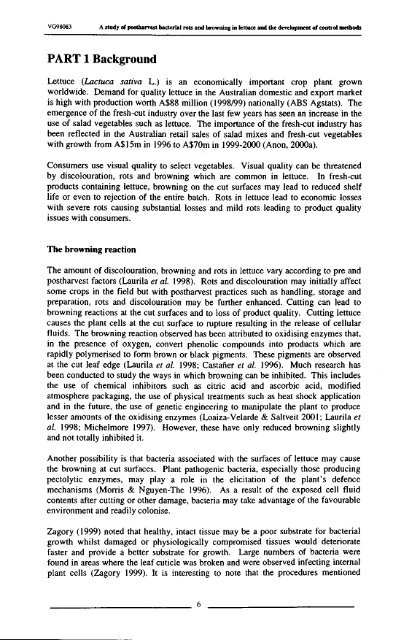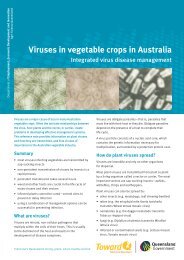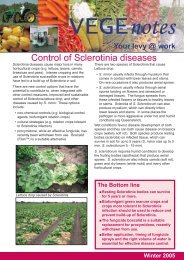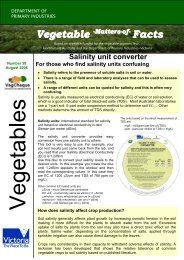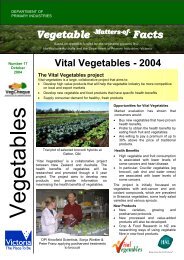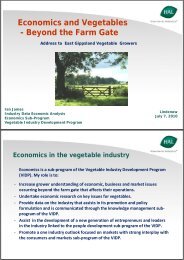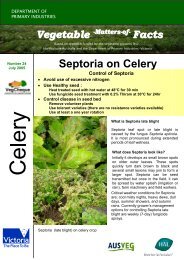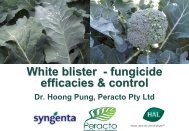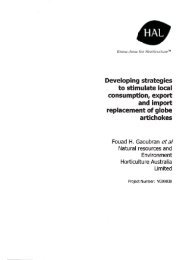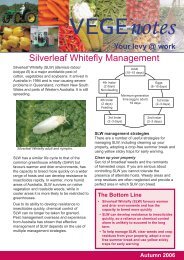Postharvest bacterial rots and browning in lettuce - Vegetable ...
Postharvest bacterial rots and browning in lettuce - Vegetable ...
Postharvest bacterial rots and browning in lettuce - Vegetable ...
Create successful ePaper yourself
Turn your PDF publications into a flip-book with our unique Google optimized e-Paper software.
VG98083A study of postharvest <strong>bacterial</strong> <strong>rots</strong> <strong>and</strong> <strong>brown<strong>in</strong>g</strong> <strong>in</strong> <strong>lettuce</strong> <strong>and</strong> the development of control methodsPART 1 BackgroundLettuce (Lactuca sativa L.) is an economically important crop plant grownworldwide. Dem<strong>and</strong> for quality <strong>lettuce</strong> <strong>in</strong> the Australian domestic <strong>and</strong> export marketis high with production worth A$88 million (1998/99) nationally (ABS Agstats). Theemergence of the fresh-cut <strong>in</strong>dustry over the last few years has seen an <strong>in</strong>crease <strong>in</strong> theuse of salad vegetables such as <strong>lettuce</strong>. The importance of the fresh-cut <strong>in</strong>dustry hasbeen reflected <strong>in</strong> the Australian retail sales of salad mixes <strong>and</strong> fresh-cut vegetableswith growth from A$15m <strong>in</strong> 1996 to A$70m <strong>in</strong> 1999-2000 (Anon, 2000a).Consumers use visual quality to select vegetables. Visual quality can be threatenedby discolouration, <strong>rots</strong> <strong>and</strong> <strong>brown<strong>in</strong>g</strong> which are common <strong>in</strong> <strong>lettuce</strong>. In fresh-cutproducts conta<strong>in</strong><strong>in</strong>g <strong>lettuce</strong>, <strong>brown<strong>in</strong>g</strong> on the cut surfaces may lead to reduced shelflife or even to rejection of the entire batch. Rots <strong>in</strong> <strong>lettuce</strong> lead to economic losseswith severe <strong>rots</strong> caus<strong>in</strong>g substantial losses <strong>and</strong> mild <strong>rots</strong> lead<strong>in</strong>g to product qualityissues with consumers.The <strong>brown<strong>in</strong>g</strong> reactionThe amount of discolouration, <strong>brown<strong>in</strong>g</strong> <strong>and</strong> <strong>rots</strong> <strong>in</strong> <strong>lettuce</strong> vary accord<strong>in</strong>g to pre <strong>and</strong>postharvest factors (Laurila et al. 1998). Rots <strong>and</strong> discolouration may <strong>in</strong>itially affectsome crops <strong>in</strong> the field but with postharvest practices such as h<strong>and</strong>l<strong>in</strong>g, storage <strong>and</strong>preparation, <strong>rots</strong> <strong>and</strong> discolouration may be further enhanced. Cutt<strong>in</strong>g can lead to<strong>brown<strong>in</strong>g</strong> reactions at the cut surfaces <strong>and</strong> to loss of product quality. Cutt<strong>in</strong>g <strong>lettuce</strong>causes the plant cells at the cut surface to rupture result<strong>in</strong>g <strong>in</strong> the release of cellularfluids. The <strong>brown<strong>in</strong>g</strong> reaction observed has been attributed to oxidis<strong>in</strong>g enzymes that,<strong>in</strong> the presence of oxygen, convert phenolic compounds <strong>in</strong>to products which arerapidly polymerised to form brown or black pigments. These pigments are observedat the cut leaf edge (Laurila et al. 1998; Castaner et al. 1996). Much research hasbeen conducted to study the ways <strong>in</strong> which <strong>brown<strong>in</strong>g</strong> can be <strong>in</strong>hibited. This <strong>in</strong>cludesthe use of chemical <strong>in</strong>hibitors such as citric acid <strong>and</strong> ascorbic acid, modifiedatmosphere packag<strong>in</strong>g, the use of physical treatments such as heat shock application<strong>and</strong> <strong>in</strong> the future, the use of genetic eng<strong>in</strong>eer<strong>in</strong>g to manipulate the plant to producelesser amounts of the oxidis<strong>in</strong>g enzymes (Loaiza-Velarde & Saltveit 2001; Laurila etal. 1998; Michelmore 1997). However, these have only reduced <strong>brown<strong>in</strong>g</strong> slightly<strong>and</strong> not totally <strong>in</strong>hibited it.Another possibility is that bacteria associated with the surfaces of <strong>lettuce</strong> may causethe <strong>brown<strong>in</strong>g</strong> at cut surfaces. Plant pathogenic bacteria, especially those produc<strong>in</strong>gpectolytic enzymes, may play a role <strong>in</strong> the elicitation of the plant's defencemechanisms (Morris & Nguyen-The 1996). As a result of the exposed cell fluidcontents after cutt<strong>in</strong>g or other damage, bacteria may take advantage of the favourableenvironment <strong>and</strong> readily colonise.Zagory (1999) noted that healthy, <strong>in</strong>tact tissue may be a poor substrate for <strong>bacterial</strong>growth whilst damaged or physiologically compromised tissues would deterioratefaster <strong>and</strong> provide a better substrate for growth. Large numbers of bacteria werefound <strong>in</strong> areas where the leaf cuticle was broken <strong>and</strong> were observed <strong>in</strong>fect<strong>in</strong>g <strong>in</strong>ternalplant cells (Zagory 1999). It is <strong>in</strong>terest<strong>in</strong>g to note that the procedures mentioned


